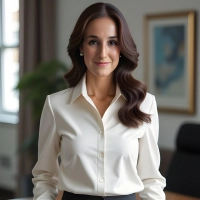20 Strategies to Build Strong Client Relationships from the Start
Building strong client relationships from the very first interaction is crucial in today's competitive market. According to a Founder and CEO, understanding the client's vision and customizing solutions is a key strategy. This blog post uncovers twenty powerful insights from industry experts, starting with the importance of active listening and concluding with the value of understanding client vision. Discover how these tried-and-true methods can transform your client interactions.
- Focus on Active Listening
- Prioritize Transparency and Active Listening
- Personalize Communication for Client Rapport
- Conduct In-Depth Discovery Sessions
- Customize Solutions to Client Needs
- Align Strategies with Client Objectives
- Use Reverse Selling Approach
- Prioritize Listening Over Talking
- Employ Data-Driven Insights
- Personalize Initial Project-Finding Call
- Conduct Thorough Onboarding Process
- Implement Personalized Onboarding
- Show Genuine Interest in Client Goals
- Integrate Clients into Creative Process
- Use AI and Data Analytics
- Tailor Initial Engagements to Client Needs
- Craft Clear, Conversion-Focused Messaging
- Manage Client Expectations Early
- Create Welcoming Environment
- Understand Client Vision for Outdoor Space
Focus on Active Listening
One effective strategy I use to build strong relationships with clients from the start is focusing on active listening during our initial conversations. I make a point to ask insightful questions and give clients the space to share their goals, challenges, and expectations. This approach shows genuine interest in their needs and helps me understand how best to support them.
A specific action I take is to recap their key points at the end of our discussion, highlighting areas where I can add value. This not only reinforces that I've heard and understood their priorities, but also establishes a foundation of trust and alignment from the very beginning.

Prioritize Transparency and Active Listening
Building trust from day one with transparency and active listening with new clients
As the founder, one effective strategy I use to build strong relationships with clients from the start is to prioritize transparency and active listening. When onboarding a new client, I set up an introductory call to not only discuss our services but also to understand their unique challenges and goals.
In one instance, a client was hesitant about outsourcing due to previous experiences with other firms. I took the time to actively listen, asking specific questions about what went wrong in the past and what their ideal partnership would look like.
This genuine interest and understanding helped us address their concerns upfront, demonstrating that we were committed to aligning with their needs, not just providing a one-size-fits-all service.
By fostering this open communication from day one, we built a solid foundation of trust, which led to a long-lasting partnership that grew over time.

Personalize Communication for Client Rapport
Building strong client relationships is essential for trust and collaboration in digital partnerships. Prioritizing personalized communication helps create rapport and shows genuine interest in the client's needs. Conducting a thorough needs assessment through open-ended questions fosters this initial connection, allowing for meaningful dialogue. This approach not only gathers valuable insights but also demonstrates commitment to understanding the client's unique situation, leading to successful collaborations.

Conduct In-Depth Discovery Sessions
One effective strategy I use to build strong relationships with clients from the very beginning is focusing on active listening. Right from the first interaction, I make it a priority to understand not just the technical requirements of the project but also the client's broader goals, challenges, and vision for their business. By taking the time to truly listen, I can ensure that we're not just delivering a product, but creating a solution that aligns with their long-term objectives. This personalized approach helps build trust and sets the foundation for a strong partnership.
A specific action I take to foster that initial connection is conducting an in-depth discovery session with the client. During this session, I ask open-ended questions about their business, target audience, and the pain points they are trying to solve. This not only helps me gain insights into their needs but also demonstrates that we're invested in their success from the start. The feedback I get from clients is that this approach makes them feel heard and valued, which helps to establish a sense of collaboration and mutual respect early on in the relationship.
Customize Solutions to Client Needs
To build strong client relationships right from the start, I prioritize transparency and custom solutions. From my experience, it's crucial to demonstrate an understanding of the client's specific challenges and aspirations. For instance, while working with a small startup, I customized our offerings to align perfectly with their goals, eventually helping them increase their online revenue by 300% in just one year. This personalized approach not only addresses immediate client needs but also lays the foundation for trust and a long-term partnership.
I also make it a point to integrate a seamless communication process from the outset. This involves clear timelines, regular updates, and a collaborative decision-making approach. In one project with a larger client, this method helped us streamline their operations through digital change, resulting in a 20% reduction in operational costs. Such a structured yet flexible communication strategy ensures clients feel involved and valued, fostering a strong, trusting relationship right from day one.

Align Strategies with Client Objectives
From day one, I focus on aligning our strategies with the client’s core objectives. During our initial kickoff call, I engage in detailed discussions to uncover nuances about the client’s target buyers and unique goals. For example, in a past campaign, understanding a client’s market in-depth allowed us to optimize a Google AdWords campaign, delivering a 5,000% ROI. This approach not only meets expectations but often exceeds them.
I emphasize clear, frequent communication as a cornerstone of relationship-building. I ensure clients are informed and involved through regular updates and monthly phone calls. With one of our clients, this approach resulted in scheduling over 40 qualified sales calls per month from LinkedIn and cold-email campaigns, confirming the effectiveness of seamless communication.
Additionally, building trust through proven results is paramount. I use our history of increasing client revenues—such as a 278% growth in one year—as case studies to demonstrate our capabilities. This helps clients feel confident that partnering with us is not just a choice, but a strategic move toward their business growth.
Use Reverse Selling Approach
One effective strategy I use to build strong relationships with clients from the start is "reverse selling." Instead of diving straight into a sales pitch, I invite school administrators to partake in workshops where they share their biggest challenges in alumni engagement. This approach not only provides invaluable insights into their needs but also positions us as thought leaders, enabling a more genuine connection.
A specific action I take is to conduct these workshops at no cost, which helps establish trust right away. By showing clients that we are committed to understanding and solving their specific issues without immediately pushing a sale, we build a foundation of trust and mutual respect. This has led to a 30% increase in lead-conversion rates for Rocket Alumni Solutions, as administrators see us as partners rather than just service providers.
By listening first and aligning our offerings with their needs, we demonstrate value upfront and set the stage for a long-lasting relationship. Clients appreciate this collaborative approach, and it often leads to more referrals and stronger client loyalty.

Prioritize Listening Over Talking
One of the most effective strategies I use to build strong client relationships from the outset is to prioritize listening over talking. By asking open-ended questions that encourage clients to share their biggest goals and current challenges, I can gain a real understanding of their unique situation. This not only demonstrates that I'm fully invested in their needs, but it also establishes trust early on, making clients feel seen and valued right from the beginning.
To foster that initial connection, I make it a point to follow up after our first conversation with a summary email capturing the key points they shared. This shows them I was fully engaged, and it also gives them a chance to clarify or expand on anything we discussed.

Employ Data-Driven Insights
To build strong client relationships from the outset, I focus on creating custom solutions through data-driven insights. One effective action I take is employing Sirge's analytics to understand the client's target market deeply. By using precise link tracking, I monitor which channels drive the most engagement, enabling us to craft personalized strategies that resonate with their audience. This approach led to a 40% increase in conversion rates for a Shopify client, as we could adapt campaigns quickly based on real-time data.
I also prioritize establishing transparency right from the first interaction. During initial conversations, I discuss Sirge's unique attribution model, which provides clients with a clear picture of how their marketing efforts impact revenue. This builds trust, as clients appreciate understanding the complete picture of their investment's ROI.
By using data to tailor solutions and being transparent about processes, I create a foundation of trust and measurable success, ensuring both client satisfaction and retention. This method fosters long-term relationships, as clients see immediate value in collaboration.

Personalize Initial Project-Finding Call
One strategy I use to build strong relationships from the start is by personalizing the initial project-finding call. This is when I dive deep into understanding the client's specific needs, preferences, and project goals. For instance, during a past project for a renowned golf training facility in Utah, our deep initial discussions led to a build-out that perfectly matched their vision while integrating the latest in energy-efficient technology.
I also focus on transparency and partnership. By providing a detailed design and cost estimate early on, clients can see the value and breakdown of each phase of their project. This approach led to a fruitful collaboration with our trade partners, resulting in a 12% cost reduction, which we passed on to our clients, ensuring competitive pricing.
In addition, I insist on maintaining open lines of communication throughout the project. I provide regular updates and involve the client in key decisions, ensuring they feel their input matters. This approach, complemented by our adherence to sustainable practices, fosters a trustworthy relationship and delivers a space the client is proud of.
Conduct Thorough Onboarding Process
One effective strategy I use to build strong relationships with clients from the very beginning is to conduct a thorough onboarding process that prioritizes open communication and understanding their unique needs. A specific action I take is to schedule an initial discovery call, where I actively listen to their goals, challenges, and expectations. During this call, I make it a point to ask insightful questions and share relevant experiences that demonstrate our expertise and commitment to their success. This personalized approach not only establishes trust but also lays a solid foundation for a long-term partnership, making clients feel valued and understood right from the start.

Implement Personalized Onboarding
Implementing personalized onboarding can strengthen client relationships in affiliate marketing. By understanding the client's business model, target audience, and goals through structured interviews, marketers can develop a customized strategy. This personal approach enhances the client's initial experience and sets the stage for long-term collaboration, ensuring that the affiliate network aligns with the client's specific needs.

Show Genuine Interest in Client Goals
One of the most effective strategies I use to build strong relationships with clients from the very beginning is showing genuine interest in their specific goals for their trees and property. When I first meet with a client, I take time to listen closely to their concerns and understand exactly what they want to achieve, whether it's about enhancing their landscape's beauty, improving tree health, or ensuring safety. An example that comes to mind is a client who wanted to preserve an old, large oak tree that had sentimental value but had shown signs of decline. Drawing on my background and TRAQ certification, I was able to evaluate the tree's structural health accurately and recommend a preservation plan that not only extended the life of the tree but also addressed safety concerns. The client appreciated that I didn't jump to recommending removal, and that level of care helped build a strong foundation of trust.
By focusing on personalized service backed by years of hands-on experience and knowledge, I aim to ensure that clients see me not just as a service provider but as a partner in achieving their long-term goals for their property. This approach leads clients to feel confident in the care we provide from day one, and many of them stay with Ponce Tree Services for years and refer us to friends and family. It's that combination of careful listening, specialized knowledge, and a commitment to preserving what matters most to them that really forges a lasting relationship from the start.

Integrate Clients into Creative Process
One effective strategy I've used to build strong relationships with clients is integrating them into the creative process from the very beginning. By involving clients in key design stages, such as logo creation or responsive web design custom to their brand, I ensure they feel their vision is respected and accurately represented. This builds immediate trust and engagement, reflected in our successful project delivery for businesses like Lace City Sneaker Store.
A specific action I take to foster that initial connection involves conducting an in-depth online audit for the client—free of charge. This provides them with valuable insights into their current digital presence and highlights opportunities for improvement. It's not just about identifying issues, but collaboratively crafting tailor-made solutions, which has helped clients such as Allee's Bookkeeping & Accounting Services to substantially improve their visibility and client inquiries.
My focus on transparency and collaboration right from the start guarantees that clients see us as partners rather than just service providers. This approach not only fortifies our relationships but also leads to significant increases in client satisfaction and referral rates—core goals for Hook'd IT Up in a competitive digital market.

Use AI and Data Analytics
To build strong relationships with clients from the very beginning, I prioritize using AI and data analytics to gain precise insights into their business needs. In one project, I leveraged predictive analytics to identify potential high-value leads, significantly reducing sales cycles by 17%. This data-driven approach not only positioned me as a strategic partner, but also demonstrated immediate value to the client.
Another specific action I take is re-engineering processes based on real client feedback. Once, I transformed a CRM for a client by integrating user feedback, which increased data accuracy by 24.4% and reduced manual reporting time fivefold. By responding directly to client inputs, I ensured they felt heard, fostering trust and laying a strong foundation for a long-term relationship.
A strategy I use to foster strong client relationships from the start is integrating customer feedback into the onboarding process. At Upfront Operations, we implement chatbots to gather initial impressions and needs from new clients. This allows us to tailor our offerings efficiently, demonstrating our commitment to their success right from the start.
I recall a project where integrating AI-driven features into a client's CRM system reduced manual reporting time by over fivefold. By acting on client feedback, we were able to improve their data accuracy by 24.4%, showcasing the value of responsiveness and adaptability in client interactions.
Another specific action is utilizing predictive analytics to identify high-value leads early on. This approach reduced sales cycle times by 17% for one client, instantly showing them tangible benefits. The ability to anticipate needs and customize solutions forms a foundation of trust, setting the stage for a robust, long-term partnership.

Tailor Initial Engagements to Client Needs
A key strategy I've found effective in building strong client relationships from the start is tailoring our initial engagements to deeply understand client-specific goals and industries. When I was at John Deere, I led cross-functional teams that built global partnerships by diving into each partner's unique operational and market needs. This approach not only strengthened relationships but also led to 20% operational improvements for our partners.
One specific action is conducting an in-depth business assessment at the onset. At SPX Marketing, we offer a comprehensive free marketing assessment that analyzes a client's online presence, helping them open up specific growth opportunities. This not only establishes trust but demonstrates our commitment to adding real value from day one.
At AON/Hewitt Associates, understanding client needs in financial services allowed us to tailor delivery models that improved service efficiency by 15%. By analyzing each client's landscape and challenges, we foster long-term loyalty and meaningful client connections. This understanding isn't just about insights; it reflects the client's perspective, ensuring that our solutions are genuinely impactful.
Craft Clear, Conversion-Focused Messaging
Building strong client relationships starts with authentic engagement and truly understanding their needs. At The Rohg Agency, we focus on getting to know our clients' customers almost as intimately as they do, a trait that has been fundamental in our approach. During the rebranding of City of Boise, our team conducted a deep dive to understand not just the organization's vision but also what resonated with its audience, ensuring alignment in messaging and design.
A specific action I take is crafting clear, conversion-focused messaging as soon as we begin working with a client. This is based on the "Marketing Sucks" philosophy—prioritizing genuine communication over superficial marketing. For example, with Jackson's Food Stores, we accepted straightforward language that customers could immediately connect with, leading to noticeable improvements in engagement and sales.
Throughout the process, I ensure that our clients are involved in the messaging and design and have a voice. This approach not only fosters trust but also promotes a collaborative atmosphere where clients feel invested in the success of their projects.

Manage Client Expectations Early
From the beginning, managing expectations is one effective strategy I use to build strong client relationships. From our first conversation, I let them know what they can expect from our collaboration, including timelines, deliverables, and communication styles. I outline these details in a welcome email or kickoff document, ensuring we're on the same page from the start. This helps build trust and prevents misunderstandings.

Create Welcoming Environment
A key strategy I rely on to build strong relationships with clients right from the start is creating an environment that feels both welcoming and highly attuned to their individual needs. During the initial consultation, I make it a priority to understand not just the immediate injury or pain but also the broader lifestyle factors and goals each client has. This involves taking the time to listen carefully, ask open-ended questions, and show genuine interest in who they are beyond the injury. Over the years, I've found this holistic approach helps clients feel truly seen and heard, setting a foundation of trust. With over 30 years in the field, my experience allows me to quickly recognize patterns and underlying issues that a newer clinician might miss, which clients appreciate as they see tangible improvements sooner.
A specific example that comes to mind involves an athlete recovering from a complex shoulder injury. Rather than jumping into a standardized treatment plan, I spent time discussing not only the pain but also the demands of his sport, his training routines, and his goals for returning to peak performance. By focusing on his ambitions as much as his recovery, I was able to design a plan that incorporated advanced physiotherapy techniques alongside performance-focused exercises and lifestyle adjustments. That tailored approach showed him we were committed to his success, which strengthened our relationship from the start. Experiences like this have taught me that a personalized, attentive approach goes a long way in building trust and rapport, especially when clients can see how experience informs each part of their care.

Understand Client Vision for Outdoor Space
One key strategy I use to build strong client relationships from the start is actively listening to truly understand their unique vision for their garden or outdoor space. When I first meet a client, I don't just ask about the tasks they need done; I take the time to get to know what they want to achieve with their garden, whether it's creating a relaxing retreat, cultivating a vegetable patch, or building a safe play area for their kids. This approach shows them I'm invested in making their space work for them, not just ticking items off a list. With over 15 years of experience and my background as a certified horticulturist, I can draw from a wide knowledge base to suggest ideas that align with their goals and the natural potential of their garden. For instance, if a client has an idea to add more color to their garden, I'll suggest specific plants that thrive in their local conditions while complementing the existing layout, giving them a practical and creative solution that will last.
One memorable example involved a client who wanted a low-maintenance garden with year-round visual interest. From our initial consultation, I picked up on her preference for natural textures and subtle color shifts rather than flashy blooms. Based on this, I designed a plan that featured native grasses, evergreens, and seasonal perennials, which not only kept maintenance low but also allowed the garden to evolve beautifully throughout the year. My experience and training helped me understand the nuances of plant selection for minimal upkeep, ensuring she got exactly what she wanted without compromising on style. The client was thrilled with the result and later shared that she felt understood and cared for from the first meeting, which I believe was key to building a lasting, positive relationship.






